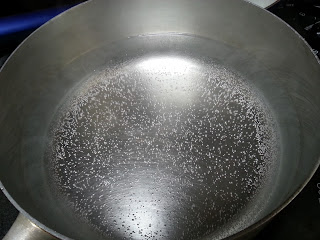If you're like us at A Book of Cookrye, you may tell yourself you will eat them and avoid waste right until mold finally takes them. For some reason, we've had a lot of fruit in our refrigerator get to this stage- where a close inspection will prove nothing is growing on it, yet no one will eat them. We could have thrown all of it out, but we feel like this about wasting perfectly good food:
Indeed, we are so adamant about preventing food waste we will even purchase new appliances just to keep semi-rotten produce out of the trash can. That's right we at A Book of Cookrye got an ice cream maker. Which leads us to... water ice!
We refer not to ice cubes but to something you can get anywhere in Philadelphia, but only in hoity-toity boutique places with pseudo-foreign names that probably end in "-erie" elsewhere in the country. What is water ice? Imagine if you will a Slurpee, but you scoop it like ice cream instead of drinking it.
 |
| Directions for Cookery in its Various Branches, Miss Leslie, 1848 |
That is a lot of instruction, isn't it? Fortunately, we live in a time when we don't need to skim scum out of our sugar, nor do we need to hand-churn ice cream.
| Philadelphia Water Ice 4 c easily juiced fruit (grapes, berries, oranges, watermelons, etc) ⅓ c sugar ⅔ c water Put the fruit in a blender. Wet a rag and squeeze all the juice out from the pulp. Pour the juice through a strainer to catch out any pulp or seeds that fell in. Boil the sugar and water until dissolved. Add to the juice. Put in an ice cream freezer and freeze until done. When it's done, pack it down again in ice and salt for a few hours to harden it (you can use your kitchen freezer instead unless it's unreliable). This makes a small quantity, but easily scales up. Note: Obviously, you could definitely skip a lot of bother by buying fruit juice and stirring the syrup into it. If you can splurge and get the not-from-concentrate stuff, it will be so much better. If you don't feel like paying the ungodly prices most stores charge for it, we recommend buying concentrate instead of bottles of juice made from concentrate and using a lot less water when making it up. Addendum: Blackberry ice is particularly delicious.
Adapted from Directions for Cookery in its Various Branches, Miss Leslie, 1848
|
While this recipe comes from a Philadelphia writer (who, judging by the fact that she had "of Philadelphia" put under her name on most of her cookbook title pages, really wanted us to know it) and is for a food still very common in the Philadelphia area, it bears little resemblance to the water ice one will typically find today. These days, it's a lot more likely to be artificially flavored than to involve actual fruit.
However, we at A Book of Cookrye brought out this recipe because there's a lot of fruit that hid in the back of the refrigerator until it looked like this.
As you can see, they're mushy and not all that great, but there's not a spot of mold or anything else on them. Therefore, we cannot bring ourselves to throw them away.
 |
| Now you can't tell if they were squishy or still fresh. |
Ever wondered what grape juice actually looks like?
There were also some subprime cherries oozing fluid into the bag they came in. No one was eating them, even though they were still perfectly good if a bit squishy.
It kind of looks like cranberry sauce, doesn't it?
Lastly, we had strawberries. These actually hadn't even started to expire yet. But as we all know, one night your strawberries are perfect, the next morning they have grown a thick fuzzy coat of mold. And so, taking advantage of their last moments of being fit for human consumption, the strawberries got blenderized too.
We then had a lot of straining to do.
Here we will give a quick note on wringing juice out through rags: choose your cloth carefully. It may seem like you want something thin to better let the juice seep through, but you're going to be squeezing it pretty hard. Thin cloth will tear and squirt out pulp through the hole. You want something sturdier. Like we noted when we made our own tomato ketchup, this is a good way to use those T-shirts you never liked. Also, if you're one of those people who distinguishes between "the good dishcloths" and the ones you actually wipe up muck with, do keep in mind that they will likely be stained.
 |
| Hooray, 100% all-natural fruit juice! |
However, as delighted as we are to finally make our own water ice, we must disclose that all that blenderizing and juice-squeezing made the kitchen look like this.
The messier a recipe gets, the pickier I get about it. If it just takes some light cleanup, I don't care if it's disappoints. But if I have to clear and wipe the counters and the cabinets and the floor, it better be worth the bother. It doesn't matter that I had nothing else to do while waiting for the ice cream maker to finish.
And so, in the fullness of time, we had... this!
And yes, it's delicious. It is amazing. It's just as good as when I lived in Philly, though eating it out of bowls rather than disposable cups did feel... odd.















